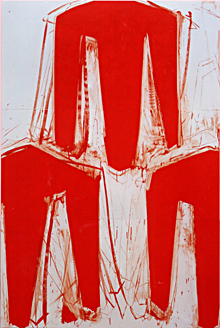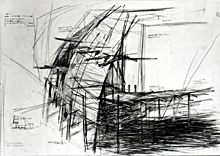5b
内部: 80年代アヴァンギャルドと新表現主義
Inside: 80's Avant-Garde and Neo-Expressionism
【本文確定】
1980年代前半の日本の美術界の「内部」を語るにあたり、2008年に登場した「80年代アヴァンギャルド」という概念を導入すると、だいぶ見通しが良くなります*5b1。これは「80年代美術はポストもの派の続きでしかない」というそれまでの史観を修正するもので、新時代に踏み出す大勢の若手美術家の感覚主義的なエネルギーを「前衛」と呼んで認めるものです*5b2。すると、この時代が「何もなかった」わけでもなければ、美術界の「外部」にのみ同時代の熱狂が偏在していたわけでもなかったことになります。美術界の内部でも外部でも、世界と同期するニューウェーブの嵐が当時吹き荒れたというわけです*5b3。
具体的には色彩やイメージが、半立体やレリーフ、あるいは「ジャンルとしてのインスタレーション」として登場しました。インスタレーションは設置あるいは展示という意味ですが、日本では1980年頃から、絵画(平面)や彫刻(立体)と並ぶもう一つの新興ジャンル名のように使われ始めました。これはこの時期に鮮やかに彩色されたレリーフが空間を意識して展開されたり(荻野裕政)、即興的なドローイングが壁と作品を跨いで施されたり(関口敦人)、原色のペインティングがオブジェやパフォーマンスと組み合わされたり(山倉研志)したことなどと無関係ではないでしょう。しばしば「バッド」な具象イメージを伴い(天野博之)*5b4、あるいは「超少女」と呼ばれた一群の若手女性作家(吉澤美香、前本彰子、菅野由美子、矢野美智子ほか)の自由な感性を媒介したそのスタイルは、マッチョに「ものを放置」してみせた前時代のもの派や、制作を再開したが禁欲が残存していたポストもの派の展示とはだいぶ趣きを異にするものでした。
1981年2月、東京神田にオープンした画廊パレルゴンが、80年代アヴァンギャルドの牙城となりました。「70年代後半の学生たちは『失画症』と宇佐見圭司が語ったような、ある種の行き詰まりにぶち当たっていた。それに対して80年代前半、パレルゴンを始めた頃になると、作家たちはもっとすごく生き生きとしてきた」*5b5。画廊を主宰した藤井雅実が1984年にまとめた冊子『現代美術の最前線』には、47名の美術家の図版とコメント、5本の座談会記録、そして藤井雅実自身の驚くべき論文が所収されています*5b6。その論文記載の分類によると、「A ネオ・フォーマリズム」としては伊藤誠、吉川陽一郎、岡崎乾二郎、松浦寿夫、黒川弘毅ほか。「B ニューイメージ」としては天野博之、吉澤美香、前本彰子、荻野裕政、矢野美智子、関口敦仁、菅野由美子ほか。「C シンボリック」としては岩瀬京子、酒井信一、ムラカミ・ヤスヒロ、川島清、竹田康宏、加茂博、大村益三、池ヶ谷肇、平林薫ほかが挙げられています。なおこの冊子は1982年5月から7月にかけて同画廊で開催された同名の連続展覧会のカタログとして当初発想されましたが、内容と所収の美術家数を拡大した経緯がありました。
1981年、東京銀座のGアートギャラリーで開催された「ニューペインテッド・レリーフ」展(荻野裕政企画)と村松画廊で開催された「ハッピーアート」展は、Bゼミ(という美術学校)の美術家たちの自主企画連続展。1982年、京都市立芸術大学ギャラリーと東京藝術大学展示室で開催された「フジヤマ・ゲイシャ」展は、両大学の院生と学生有志による自主企画交流展。後者の京都側の参加作家には池田周功、中原浩大、椿昇、杉山知子の名前も見えます*5b7。1983年、東京銀座の2箇所の画廊で開催された「ポリパラレル」(関口敦仁企画)は「フジヤマ・ゲイシャ」の流れを汲むもの。そしてこれらの「新潮流」(ニューウェーブ)は、1979年にデビューした川俣正やポストもの派の作家たちとともに、横浜市民ギャラリーの年次展「今日の作家展」や原美術館の「ハラ・アニュアル」ほかで積極的に紹介されました。
一方、世界的な絵画回帰の一環として、欧米の「バッド」な具象絵画動向に呼応した新表現主義絵画が、日本の画家のカンバス上にも現れました*5b8。ロンドンの「ラディカル・イラストレーション」のグループと親交のあった大竹伸朗は(私の記憶では)「100号の大作を3分で描いたっていいじゃないか」と言って大量の具象画を発表し始め*5b9、1960年代からサブカルチャー・シーンを牽引していたデザイナーの横尾忠則は、「画家宣言」を行って憑かれたように絵の具で描き始めました。国内外のこの動向を擁護した伊東順二著『現在美術』(1985年、パルコ出版)は美術界を超えて広く読まれ、ハイカルチャー文脈においてもポストモダン時代が到来していることを強く読者に印象づけましたが、美術界内部の評論家の多くは新表現主義自体をキッチュとして糾弾したり、日本におけるそれは欧米追随であると非難したり、あるいは大竹伸朗の作品が宣伝広告に使われたり横尾忠則がデザイナーだったりしたことから応用美術という外部と見なして無視したりしました*5b10。
そしてあからさまに「バッド」な新表現主義ではなくとも、その空気が、1970年代後半のシステミック・ペインティングから1980年代後半のフォーマリズム絵画へと続く日本の美術内美術の画家たちの筆致に影響した可能性はあると思います。辰野登恵子の1980年の変節は美術界に衝撃を与え、吉本作次、赤塚祐二、中村一美らがペインタリーな画家として登場しました*5b11。
【初版ママ】There were three aspects to the "Inside (Within)" of the first half of the 1980s Japanese art world which were installation as a genre, the refined Post Mono-ha and new expressionist paintings.
【初版ママ】Installation means "to place" or "exhibit" but since the latter half of the 1970s, it was used to mean "exhibition with awareness for place" in art parlance. In Japan, it came into use as a name for an emergent genre in art along with paintings and sculpture in the first half of the 1980s. This was because during this time, a free and extravagant colored relief sculptures came about which became the components for installations*5b1. These installations were different from the installations which derived from the context of three-dimensional forms of Mono-ha and Post Mono-ha. There were also "bad" representational images which came about*5b2, and the emergence of many female artists with sensibility who were called "choshojo (supergirls)" gave an air of a beginning of a new era.
【初版ママ】Exhibitions such as "Happy Art," held in 1981 at rental galleries in Kanda and Ginza in Tokyo, "New Painted Relief" and "The Frontline of Contemporary Art" exhibitions held in 1982 which were group shows centered on works by artists from B Seminar Schooling System showed this type of tendencies. Young male artists such as Amano Hiroyuki, Yamakura Kenshi and Ogino Hiromasa and "choshojo (supergirls)" such as Yoshizawa Mika, Maemoto Shoko, Sugano Yumiko, Yano Michiko, Hirabayashi Kaoru and Yasuda Naoko emerged from this trend. Part of this trend gave a sense of being in the same timeframe with that of the Neo-Expressionism in the West.
【初版ママ】Mixed with this trend was an emergent trend in refinement of Post Mono-ha. It did not use straightforward representational images, and were three-dimensional forms or installations where imposing profoundness was eliminated from Post Mono-ha works of the previous era. The artists of this trend included Okazaki Kenjiro, Kawamata Tadashi, Ikegaya Hajime, Kamo Hiroshi, Kurokawa Hirotake, Senzaki Chieo and Kitta Naoyuki, and some of them showed influences from American post-minimalism. The preceding trend and this trend were actively introduced at "Today's Artists" exhibition held at Yokohama Civic Art Gallery, "Hara Annual" exhibition at Hara Museum and "Parallel Art" exhibition series presided over by Minemura Toshiaki.
【初版ママ】At the same time, as part of the global "reinstatement of the paintings" and in response to trends in "bad" representational paintings in the West*5b3, new expressionist paintings began to appear on the canvases of the Japanese painters. Ohtake Shinro, who had close relationships with London's "Radical Illustration" group members, declared (in my memory) "One hundred major works can be drawn in three minutes" and started to produce huge amounts of representational drawings*5b4. Yokoo Tadanori, who has been a leading figure in the subculture scene since the 1960s, declared a "painter declaration" and started to paint obsessively. Although Ito Junji's book "Art in Front" (Parco Publishing), which defended this trend happening within and abroad, was widely read even outside of the art audience, many of the critics within the art world ignored it by denouncing Neo-Expressionism as being kitsch, or criticizing contemporary art in Japan as being followers of Western trends, or because Ohtake's works were being used for advertisements and Yokoo comes from a designer's background and therefore being commercial art and outside of the contemporary art world*5b5.
【初版ママ】During this era, other artists who also started to get involved in new wave paintings and sculptural reliefs as well as installations were Yoshimoto Sakzy, Asahina Yasuto, Akatsuka Yuji and Sekiguchi Atsuhito.

